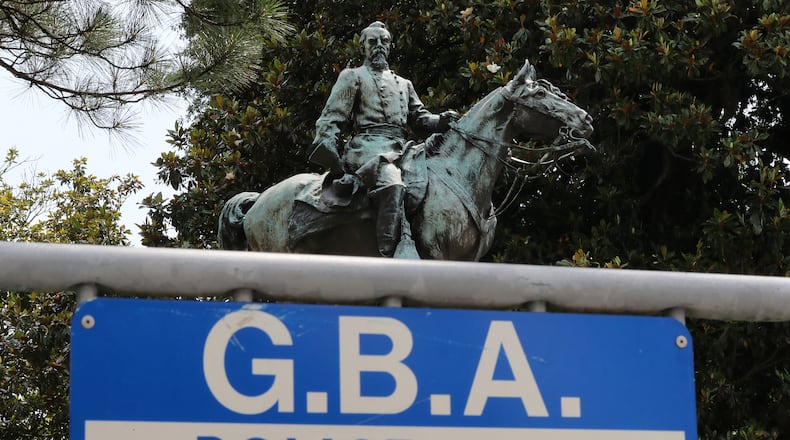On a hot Saturday night in June, while downtown Atlanta was bubbling with anger, 14 or so armored figures gathered with their backs to the statue of Confederate Gen. John Brown Gordon on the grounds of the state Capitol.
In artistic terms, a cell phone photo of the scene taken by Journal-Constitution staffer Christian Boone is lacking. Many of the state police officers are nearly invisible in the deep shadows.
And yet the image is riveting. All are helmeted and wearing masks in anticipation of the tear gas to come. All have long riot batons, with a few of the sticks held at port arms. The flower beds around the statue are taking a beating.
You could not tell from the photo, but chances were excellent that not one of the officers knew that they protected a memorial to a somewhat successful military leader, a likely grand wizard of the Ku Klux Klan, a scoundrel when it came to political ethics, and ultimately, the personal embodiment of Lost Cause mythology.
Nor were those cops likely to be able to explain why the state of Georgia has declared the horse-backed Gordon and many other monuments to be sacrosanct.
We are in the midst of another debate over the Confederacy, the institution of slavery it fought to preserve, and the violent resurgence of Southern white political power in the decades that followed the Civil War. It won’t be the last, because we lack the proper tools for a cogent discussion about a broad sweep of history that still holds us hostage.
Several days after that confrontation at the state Capitol, also in the dark of night, a crane rumbled into downtown Decatur. Hours later, a long-disputed monument to the Confederacy disappeared.
Legal maneuvering was involved. DeKalb County Superior Court Judge Clarence Seeliger had declared the tall obelisk a “public nuisance” that could pose a future danger as protests against its existence continued.
DeKalb CEO Michael Thurmond didn’t hesitate. He called in a friendly contractor for the secretive removal project.
Speed was necessary. Since 2001, when Gov. Roy Barnes hauled down the 1956 state flag with its dominant Confederate battle emblem, Confederate monuments have enjoyed a degree of state protection. That was part of the deal.
Laws protecting Confederate monuments were strengthened by the GOP-controlled General Assembly in 2019. Under most circumstances, local communities are now barred from removing them.
One day after the marker in Decatur was removed, Sheffield Hale, President and CEO of the Atlanta History Center, declared that this set of laws was likely to speed up the removal of disputed monuments rather than preserve them –“by creating more vitriol, less dialogue, and a lack of democratic options.”
"Though supporters claim that the legislation protects history, this law effectively reanimates the original purpose of monuments by a state sanction. Monuments are made untouchable and unchangeable, elevating them to objects of veneration," he wrote in a Journal-Constitution column.
I would go one step further. Any proper dialogue about the South in the years after the Civil War, when most of these monuments were raised, is hamstrung because most of us know very little about the period.
I am a product of the Fulton County Board of Education and was blessed with two excellent history teachers in high school in the ’60s and ’70s. But the rise of Jim Crow in the South was a radioactive topic. We pretty much made a bee-line from Robert E. Lee’s surrender at Appomattox Courthouse straight to Pearl Harbor.
My history teacher/daughter says things have improved. But our public spaces don't show enough evidence of that. Nowhere at Stone Mountain Park is there a marker that says the 1915 rebirth of the Ku Klux Klan occurred atop the edifice. Or that the carving on its side was funded and completed after the U.S. Supreme court ordered an end to school segregation.
And then we have Gen. John Brown Gordon, sitting astride his horse at the state Capitol. The last substantive biography on the man was completed in 1993, an impressive measure of academic disinterest.
Possibly you have noticed that journalists have fudged when it comes to Gordon’s association with the KKK. He is presumed to have become leader of the Georgia chapter in March 1868, when Nathan Bedford Forrest — also a Confederate general and an early Klan leader — visited Atlanta. (A newspaper at the time described the occasion as a meeting of two insurance company executives.)
In 1871, both Gordon and Forrest were called before a congressional committee exploring the KKK and Black voter suppression in the South.
According to biographer Ralph Lowell Eckert, during five evasive hours of testimony, Gordon denied any knowledge of the Ku Klux Klan, but admitted to joining a secret “peace police organization” for self-protection against a political system in which former slaves were being given a prominent voice.
“We would have preferred death rather than to have submitted to what we supposed was coming upon us,” Gordon testified.
Two years later, the Georgia Legislature sent Gordon to the U.S. Senate. The Democrat participated in negotiations for the removal of federal occupation troops from the South, where they had been protecting a new generation of African American citizens.
In 1880, Gordon abruptly resigned from the Senate – to become the well-paid general counsel to a local railroad company. His critics accused him of cashing in, but Gordon survived that blow to his reputation. He would later serve as governor, then return to the U.S. Senate. He died in 1904. The statue was erected three years later.
"By the time of his death he was the living symbol of the Confederacy, but that place of public honor was largely due to do the fact that he had outlived most former Confederate generals and had written a book that promoted and embellished his role as one of 'Lee's Paladins,' to use his phrase," W. Todd Groce, president and CEO of the Georgia Historical Society, told me in a thoughtful email that was far too long for this space.
“Gordon saw no use in keeping alive old wounds with the former enemy — it was bad for business and for reasserting white supremacy, which needed cooperation of the victors if it were to succeed legally. So he may have been a Georgia hero, but he never rose to the level of mythical status,” Groce wrote. “To a large extent, his fame was kept alive by force of personality rather than brilliant military or political contributions, and mostly died with him.”
The historian followed up with one more observation. Another former Confederate general, James Longstreet, died only a few days before Gordon that January. Longstreet is buried in Gainesville. But it was Gordon’s corpse that was displayed in the state Capitol.
Longstreet’s military accomplishments eclipsed those of Gordon. “But Longstreet rejected his Confederate past, became a champion of African-American rights, joined the Republican Party, insisted that slavery — not state’s rights — was the cause of the war, and was the villain of the Lost Cause,” Groce noted.
Which could lead one to suspect that martial prowess isn’t the only reason that Gordon occupies a most prominent spot on the Capitol lawn.
If one wants to argue for the removal of a statue, it is best to know what it represents. The same goes for those who would protect it.
About the Author
The Latest
Featured





